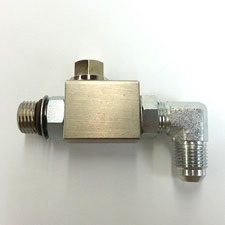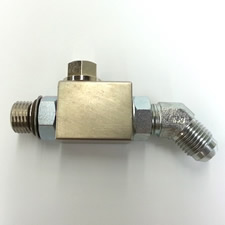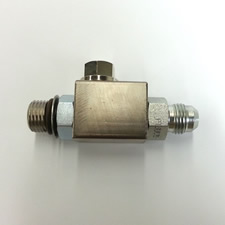RTD Sensors
RTD Sensors (resistance temperature detectors) are used in hot melt packaging systems because of their precision in sensing and proportioning temperature. They consistently maintain a temperature control stability of +/- 1-degree Fahrenheit. With the ever-increasing price of adhesive, it is important that RTD sensors are used in all of Universal Systems’ hot melt hoses and glue applicators for steady adhesive application. When combined with USSE’s patented AccuScan™ solid-state control system, RTD sensors provide precise bead uniformity for all of our ProBilt™ applicators.
Since RTD sensors are so key to the adhesive application process, it is important to check them first whenever you notice glue inconsistencies. If you see that your glue bead is not sticking properly or getting clogged, it could be caused by inconsistent glue temperature. There are several causes of inconsistent glue temperature. For example, if your tank operators are opening the cover to add glue, that will cause a temperature change. RTDs control that process, by notifying the heater to turn on and run longer when those situations occur. If your RTD is weak, then the heater will not be able to maintain steady temperature. It is the easiest, most overlooked and one of the least expensive components in your application process, but is worth it’s weight in glue!
When it comes to understanding the components that make up your adhesive application system, we believe that knowledge is power. So, if you have any questions, or think that you may be having issues with your RTD sensor, do not hesitate to call Universal Systems at (800) 848-5018 to speak with one of our technicians. We can walk your line operator through testing RTD sensors and how to switch them out correctly and safely.
The Importance of Using Aluminum for Manifolds
Universal Systems SE manufactures high quality hot melt application manifolds that will work with most all hot melt application systems. We understand the importance of durability, consistency and effectiveness in packaging manufacturing, which is why we use 6061T aluminum when making all of our manifolds.
What is a Manifold?
When evaluating what you need for your hot melt application system, it is important to understand each item that makes up the application gun. The manifold is the aluminum gun body, that houses the heater & sensor, and is where the modules mount.
Why do we use Aluminum?
Aluminum is used on all of our hot melt applicator manifolds because it is an excellent conductor of heat and dissipates heat very efficiently. Aluminum also has a very high strength to weight ratio, meaning that although it is light-weight, it is extremely strong. Its strength is what allows for peak performance during the rigorous packaging process. It is also non-toxic, cannot burn and is easily recyclable.
Why do we use 6061T Aluminum?
All of Universal System’s ProBilt™ manifolds are manufactured using 6061T aluminum. 6061T aluminum is aviation aluminum and used for the building of all jet aircrafts. This will extend the lifespan and durability of the manifold and increase it’s on the floor performance.
For more information on how to buy a hot melt gun applicator or manifold, please reach out to sales@ussefl.com or call (561) 272-5442 today!
In-Line Gun Filters
There are a couple different types of filters that you need to change out regularly on your adhesive melter system. One is a tank filter, which we describe in a previous article: The Importance of Tank Filters. The second, is the in-line gun filter. This is the filter that goes between the hot melt gun applicator and heated hose. This is the last line of defense against char being transferred through the module and potentially clogging the nozzle.
There are a three different in-line filter assemblies that are available for your hot melt system: Straight, 45 Degree & 90 Degree. The first is a filter assembly with a straight connector from the gun to the hose. This straight fitting is used when guns line up directly with hoses, typically applying the glue straight out to onto the boxes. The other two filter assemblies offer a 45 degree and 90 degree fitting that allows you to connect the hose to the gun at an angle. These filter assemblies are mostly used on setups where the applicator guns are either above or below the packaging line.
Each filter assembly is available with 50 mesh, 100 mesh and 200 mesh filters. The replacement filters are sold separately in packs of 5 for easy installation so that you do not need to switch out the entire assembly. The filter is easily screwed into the top of the filter body as seen below. Please make sure that you lubricate the o-rings before installation to help you for future filter changes.
For more information on which in-line filter assembly is best for you, please call (561) 272-5442 or email sales@ussefl.com.
Custom Manifolds & Gun Applicators
There are not many manufacturers in the hot melt industry that have the ability to work with clients and create custom manifolds and gun applicators to fit their unique needs. Universal Systems SE has that ability and is willing to pair up our engineers with our client’s team to ensure that we manufacture the exact applicator needed for any job.
Over the last forty years, Universal Systems SE has manufactured an array of different custom manifolds and gun applicator systems for different types of industries. Not only can our custom gun manifolds distribute adhesive onto boxes in packaging lines, but they can be used for distributing make-up, candle gel, etc. Depending on the viscosity and melt rate of the substance needed to make the transfer, our custom manifolds and applicators will work with several different types of materials.
The custom manifold and gun process is simple. Contact one of Universal Systems SE’s customer service representatives, by either calling in to (561) 272-5442 or submitting a custom gun online form. You will then be connected with a USSE mechanical engineer. After all of the client’s needs are communicated with our engineering team and all questions answered, USSE will provide the customer with a custom manifold drawing for approval. The drawing will include dimensions of the manifold, spacing of modules, type of modules and all cordsets that are included and the location of those cordsets. Once the drawing is signed off on by the customer, we then manufacture the manifold body. After a vigorous quality control process, each custom manifold is inspected and tested to ensure all dimensions are correct and that the custom gun matches the approved drawing. Once the manifold passes all initial testing, modules are added and the custom gun is created and tested internally by two different QC Engineers. Once there is approval by both engineers, the final product is cleaned and ready for shipping.
The normal process for custom manufactured manifolds and completed guns is four to six weeks, with extra time potentially added in depending on customer turnaround time for drawing approvals.
If you are interested in learning more about the types of custom manifolds and gun applicators that Universal Systems SE can engineer for you, please call (561) 272-5442 or email sales@ussefl.com.
The Difference Between a Glue Gun Head and Module
By far, the most commonly asked question we receive is – what is the difference between a glue gun and a module? A misconception that many packaging line buyers make is that when a module fails, you need to replace the entire gun. That is not true. In most cases, the modules attach to the gun and can be easily removed and replaced.
Below is a breakdown of the components that comprise a hot melt adhesive gun application system:
- Gun Head – this is the gun body that attaches to the packaging line and initiates the application of melted adhesive into the module. There are a variety of different style gun heads, ranging from 1 module to multi module capacities.
- Module – the module attaches to the gun head via two screws. Each gun applicator will come with modules, but these can be replaced regularly once they get clogged. The module is the conduit that applies the adhesive to the package.
- Nozzles (not always included when you purchase a gun) – at the end of every module is a nozzle. Most standard nozzles will screw on to the end of the module. The diameter of the nozzle will determine how much hot melt is applied to each package. Some modules, such as reduced cavity, zero cavity and ProBead’s, will come with an integrated nozzle seat attached. Replacement kits for these integrated nozzles are sold separately, instead of buying a brand-new module.
If you only need to replace the module, and not the entire gun applicator, make sure you check which type of module you need. Below is a list of the most common modules in use today.
- Standard H200 Module
- ProBead Self-Cleaning Module
- Reduced Cavity H200 Module
- Zero Cavity Micro Adjust H200 Module
- Swirl Pattern Modules
- Weave Pattern Modules
- H20 Modules
If you have any questions on which items you may need, please reach out to a sales representative by either calling (561) 272-5442 or emailing sales@ussefl.com. We manufacture all products in the United States and are here to offer the best price possible to get your packaging line up and running as quickly as possible.





